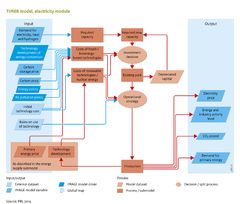Energy conversion: Difference between revisions
Jump to navigation
Jump to search
m (Text replace - "Carbon storage cost;" to "Carbon storage price;") |
m (Text replace - "Activity level;" to "Energy and industry activity level;") |
||
| Line 5: | Line 5: | ||
|KeyReference=Hoogwijk et al., 2007; Hendriks et al., 2004a; | |KeyReference=Hoogwijk et al., 2007; Hendriks et al., 2004a; | ||
|InputVar=Technology development; Energy policies; Air pollution policies; Demand for electricity and hydrogen; Primary energy price; Carbon storage price; Carbon price; | |InputVar=Technology development; Energy policies; Air pollution policies; Demand for electricity and hydrogen; Primary energy price; Carbon storage price; Carbon price; | ||
|OutputVar=Electricity price; Demand for primary energy; CO2 stored; | |OutputVar=Electricity price; Demand for primary energy; CO2 stored; Energy and industry activity level; | ||
|Parameter=Initial technology cost; Rules on use technologies; | |Parameter=Initial technology cost; Rules on use technologies; | ||
|Description=Energy from primary sources often is first converted into secondary energy carriers that are more easily accessible for final consumption. Examples of such conversion processes relate to the production of electricity and hydrogen, oil products from crude oil in refineries, and the production of fuels from biomass. Electricity (and in the future possibly also hydrogen) is produced by the conversion of primary energy carriers, such as fossil fuels, fissile materials (uranium), and various renewable energy sources. Studies on transitions towards more sustainable energy systems tend to show the importance of these conversions for the future. | |Description=Energy from primary sources often is first converted into secondary energy carriers that are more easily accessible for final consumption. Examples of such conversion processes relate to the production of electricity and hydrogen, oil products from crude oil in refineries, and the production of fuels from biomass. Electricity (and in the future possibly also hydrogen) is produced by the conversion of primary energy carriers, such as fossil fuels, fissile materials (uranium), and various renewable energy sources. Studies on transitions towards more sustainable energy systems tend to show the importance of these conversions for the future. | ||
Revision as of 16:35, 30 January 2014
Parts of Energy conversion
| Component is implemented in: |
|
| Related IMAGE components |
| Projects/Applications |
| Models/Databases |
| Key publications |
Key policy issues
- What is the potential role of energy conversion sector, particularly in power production, in achieving a more sustainable energy system?
- What are the potential roles of individual technologies, such as carbon capture and storage (CCS), nuclear power, hydrogen and renewable energy?
